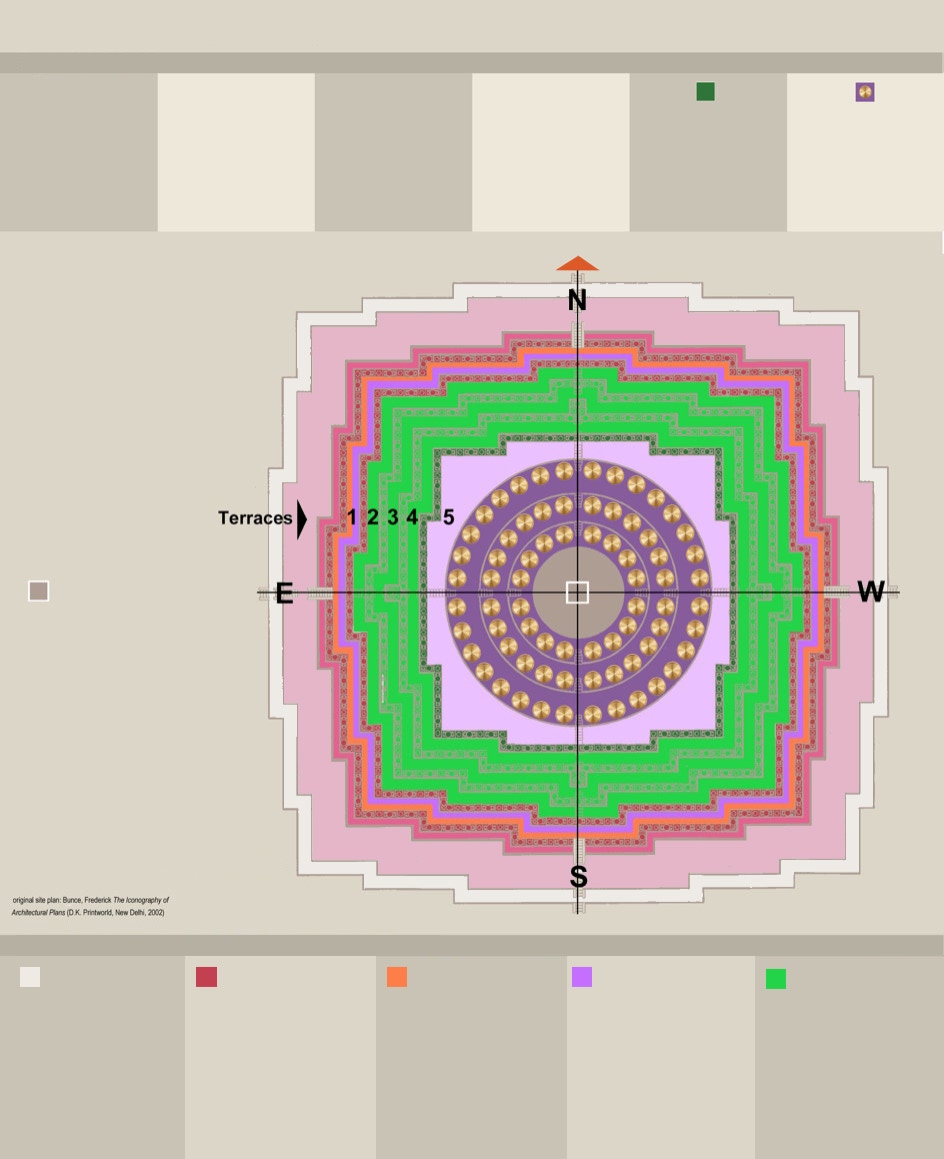
Key to the 504 Buddhas
92 east-facing Buddhas: Buddha: Akshobhya ("immovable") Buddha wisdom: vajra (diamond, clarity) mudra: bhumisparsa (earth-touching, dispelling ignorance)
** The identity of the Buddhas on the 5th terrace and in the dagobas is uncertain and an alternative has been suggested for both: Buddha: Vajradhara (vajra, thunder or diamond-holder) Buddha wisdom: sunyata (emptiness, the non-manifest dharmakhana or “Buddha essence”) mudra: dharmachakra (“first turning of the wheel of dharma”)
92 south-facing Buddhas: Buddha: Ratnasambhava (“born from a jewel”) Buddha wisdom: ratna (jewel, all-inclusive equanimity) mudra: varada (generosity, granting wishes)
92 west-facing Buddhas: Buddha: Amitabha (“infinite light”) Buddha wisdom: padma (lotus, compassion) mudra: dhyani (meditation)
92 north-facing Buddhas: Buddha: Amoghasiddhi (“infallible accomplishment”) Buddha wisdom: karma (effective means) mudra: abhaya (fearlessness, reassurance)
*64 Buddhas on the 5th terrace: Buddha: the historical Buddha (“the awakened one”) Buddha wisdom: dharma (doctrine) mudra: vitarka (teaching)
*72 Buddhas in stupas or dagobas: Buddha: Vairocana (“essential radiance”) Buddha wisdom: tathagata (“thusness”) mudra: dharmachakra (“first turning of the wheel of dharma,” Buddha’s first sermon at the deer park, Sarnath)
2 empty chambers in the stupa
Key to texts illustrated on the 1460 narrative bas relief panels
1. Karmavibhangga (The Law of Karma, moral fables) 160 panels hidden by the added base or “false foot”
2. Jatakas (Birth stories of the 547 previous incarnation of the historical Buddha from the Pali Canon) 600 panels on the 1st and 2nd terrace balustrades
3. Avadanas (Legends of Illustrious Men) 120 panels on the 1st terrace’s lower register
4. Lalitavistara (The Unfolding of the Play, scenes from the life of the historical Buddha, Siddhartha Gautama, the bodhisattva, Sakyamuni, up to his first sermon at Sarnath) 120 panels on the 1st terrace’s upper register
5. Gandavyuha (The Structure of the World Compared to a Bubble from the Flower Ornament Sutra and its sequel the Bhadraari Sutra, the youth Sudhana’s journey to enlightenment) 460 panels on the 2nd, 3rd and 4th terraces’ two registers and balustrades
FIGURE 10: SITE PLAN ANALYZING THE BUDDHAS AND BAS RELIEFS AT BOROBUDUR (770-830)
The tripartite ontology of Borobudur’s terraces also maps onto the three components of Buddhist psychology, citta, vijana and manas, roughly, emotion, awareness and mind, or Freud’s libido, ego and superego. A fourth, prajnaparamita,“the perfection or essence of wisdom,” is the awareness of the non-existence of mind, the emptiness of all mental forms or tathagata, “thusness” (in opposition to “thisness,”) the final level of consciousness; nonetheless, as awareness, it exists and is still a form of consciousness which must be lost to achieve parinirvana total non-existence. This can, logically, only be marked by an absence – at Borobudur by two empty chambers built into the large stupa above the 5th terrace. In architectural terms, the monument corresponds with the concentric squares of the vastu purusha mandala, the outer two assigned to demons and men, the next to the gods and the inner to the creator god, Brahma, himself only a manifestation of the invisible absolute, Brahman, whose emanations they all are. This triad has also been compared with a temple’s feet, body and head, as well as Mt. Meru’s foothills, slopes and summit, which it symbolizes.
The youth, Sudhana’s, journey seems intended to parallel or model that of the pilgrim. It would take ten circuits of the temple, nearly three kilometers, to trace each of the narrative strands carved along the bas relief panels; perhaps, not coincidentally, ten is the same number of steps, paramitas or attainments prescribed for becoming a bodhisattva, (see appendix III.) The careful ordering of these five texts may suggest that sections of the temple were open only to those who had mastered the previous stages or “transcendent practices,” that is, practices for transcending samsara, attachment, desire and the resulting reincarnations, found in Mahayana and Vajrayana Buddhist sutras.